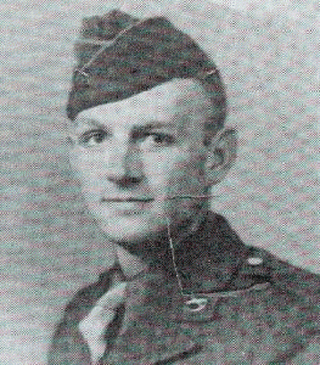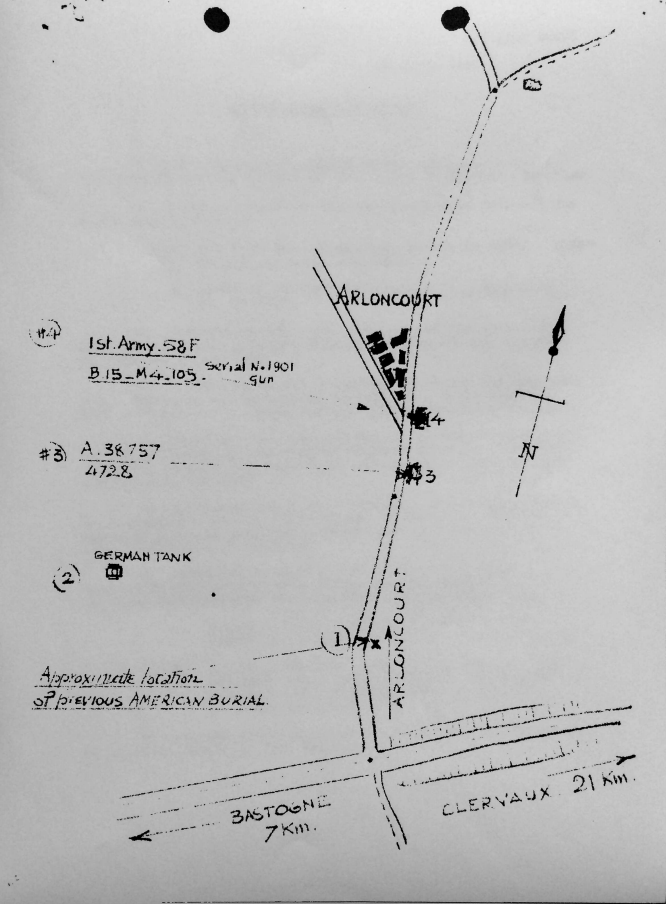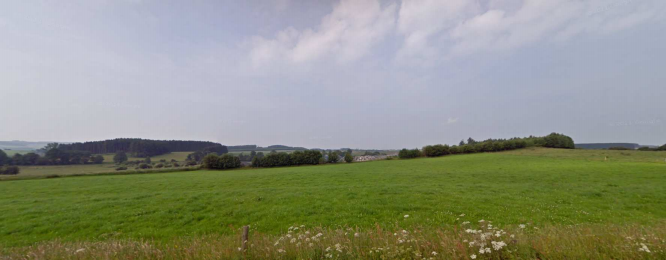The search for deceased and missing US soldiers went on for years after the end of WWII.
Many men and vehicles were left at the battlefields, often found by accident by locals.
Pvt. Bernard Paul Posey of A Company 50th Armored Infantry Battalion was one of the men who was temporarily missing in action before being declared killed in action. Pvt. Posey is mentioned in an investigation into the remains of another US soldier that were found in the driver's seat of an M-7 Self-Propelled gun that was left on the battlefield:
12 April 1947
Report of investigation
1. Investigation conducted in the Arloncourt area failed to locate the remains of Pfc. Alvin B. Huffman.
2. Physical search of the Arloncourt area revealed the following US vehicles (two years after the end of the war, the vehicles were still in the same location as where they were put out of action):
a. M-7 (105MM) No markings except "D 38757 - 4128" on M4 gun mount available.
b. M-7 (105MM) bearing markings "1A 58F B15, USA 4039607".
3. A search of the above vehicles and the surrounding area was made with negative results. Sketch showing location of vehicles is enclosed.
4. A physical search including the Bourcy and Longvilly areas failed to locate vehicle No. 4065371. It is believed that this vehicle has been salvaged and removed from the area.
5. Statement was obtained from G. Fiasse of Longvilly who is salvaging and removing US vehicles from the Arloncourt area. No remains have been found during any of his removals. Statement is enclosed.
6. Interrogation of E.J. Rouling, forest guard, living in Arloncourt, revealed that remains of five American deceased had been previously disinterred from the Arloncourt area. Statement is enclosed.
7. Reference is made to Par. 6 above. A check of records in this headquarters indicates that the following American deceased were recovered from the Arloncourt area:
a. Harmon F Yates from coordinates P-6160 by the 3043rd QM Graves Registration Co.
b. Melvin W Padgett, Bernard Paul Posey, David Segal, Unknown X-90 by the 601 QM Graves Registration Co.
8. All the above-mentioned deceased were reinterred in US Military Cemetery, Foy, Belgium.
Statements of G. Fiasse and E.J. Rouling:
--------------------------------------------------------------------------------------------------------------
Longvilly, 11 Apr 47
I, the undersigned, in charge of American tanks salvage, declare that in November 1946, I took apart a tank on the road Bastogne-Clervaux and Arloncourt. I have not found anything in that tank, and have no knowledge of American bodies.
s/ G. Fiasse
--------------------------------------------------------------------------------------------------------------
Arloncourt, 9 Apr 47
I, the undersigned, policeman in the community of Longvilly, declare that in August 1945, there were five American bodies buried two hundred meters from Arloncourt.
I have reported them to the Officer in charge of the disinterments, and also the presence of bones left in a half-track. I remember that one of the two bodies buried near the half-track, in the ditch along the road, was very tall, about one meter eighty-five centimeters, but not very fat.
s/ E.J. Rouling
Woods Keeper
Arloncourt-Longvilly
--------------------------------------------------------------------------------------------------------------
Map showing the location of the American vehicles and the location of the burial:


The maps above show that there were four M7 Priests of the 58th Armored Field Artillery left on the battlefield just south of the town of Arloncourt. In vehicle number two, the remains of a US soldier were found. The investigation shows that just south of those M7's, two half-tracks were left. In a ditch next to these half-tracks, the bodies of 5 US soldiers were buried.
One of these soldiers was Bernard Paul Posey.

Document listing the names of the soldiers who were recovered from the ditch.

Bernard Posey was killed in action January 15th 1945 after just two days at the front, his brother John tells the story:
Paul was amongst 7000 replacement soldiers loaded on Christmas night, 1944 aboard the troopship USS George Washington in New York harbor. After docking Greencock, Scotland on New Years eve, another ten days of travel by train, boat and truck to Southampton harbor, across the Channel to LaHavre and through northern France into Belgium, took him to a forward staging area near Bastogne, a few miles behind the battle line. On or about January 10, he was trucked to his assigned unit, Company A 50th Armored Infantry Battalion. That was the date of his last letter home, scribbled in pencil, saying only that "thins are not too bad".
His company sorely needed every man, having just fought off a bruising enemy counterattack in which all officers and nearly half its enlisted personnel had been killed or wounded, with command passing to its first sergeant George P Rimmer.
Posey's baptism of fire came on January 13 when the company and other units attacked and retook the crossroads town of Mageret after a day of fierce hand-to-hand combat.
Two days later, on January 15 at 10:30am (according to Sgt. Rimmer), as the company was advancing two miles beyond Mageret, Posey and other comrades lost their lives when their tank column came under heavy artillery and mortar fire from a nearby forested area. A few days later, Rimmer himself was severely wounded, his belated battlefield commission reaching him in a hospital in England.
Due perhaps to the chaos and confusion in battle, there was considerable delay and misinformation in the military's handling of this grievous family tragedy. After receiving Posey's last letter of January 10, the family heard nothing from him of from the army for nearly seven weeks, until February 28. On that date they were notified only that he was missing in action, leaving open the possibility that he had been taken prisoner and would likely be released as our forces moved into Germany. It was this hope that the family was clinging on to on March 8 when Paul and Ruth's
second daughter, Paulanna was born. But her father would never hold his newborn baby in his arms, nor would he ever again feel the arms of her older sister Pat, not yet three years old, in a warm embrace around his neck. As weeks passed, hopes rose with every news story that our forces, advancing deep into enemy territory, were freeing thousands of American soldiers from German POW camps, only to fall again as there was nothing but silence from the War Department on Paul's status.
It was not until May 1, fourteen weeks after Paul's death, and only six days before Germany's surrender, that a telegram arrived notifying the family that he had been killed in action on January 15, 1945 "near Mageret, Belgium". This delay has never been explained, and one can only imagine how much additional pain it must have brought to a small-town Kentucky family trying to deal with their devastating loss.
John continuous:
Years ago, when I first made contact with then-living 50th Armored Infantry Battalion veterans, my hope was to find someone who might have remembered my brother Paul during this very brief service in A Company, but that was largely unsuccessful. I was told (very gently) that the combat-experienced men in the unit purposely avoided getting to know the replacements too well, knowing what a high percentage of the new men would never survive their first few encounters with the enemy.
A couple of years after WWII ended, my brother Caroll ( an Air Force officer) located 1st Sergeant Rimmer, who was acting Commanding Officer of A Company at the time of Paul's death ( all officers in A Company had become casualties the week before). Caroll arranged to have him meet with my mother to discuss the circumstances of Paul's death.
Her diary entry of March 8, 1947 briefly describes that meeting:
"Mr. Rimmer told us that Paul's tragedy took place at 10:35 AM (1/15/45). It was about his third engagement, and Paul was very frightened. Snow was knee deep and thermometer low. He was wearing a field jacket and olive drab suit. He volunteered to fill the vacancy made by a companion getting killed. Many men fell under the same fire. Mageret had been saved and following orders to clear the woods and take the next village, the German Tiger tanks opened fire that took our Paul away. Rimmer was promoted to Lieutenant but was shot in the stomach.
Critically wounded he was hospitalized for 8 weeks before being sent home to the States. It must have been a furious fight. Rimmer said ministers were close at hand and all boys were prepared for the worst...."
My mother tried to stay in touch with Rimmer, but was informed that a few years later he had taken his own life. Truly a delayed casualty of his combat experiences.
John also located another sergeant in Paul's squad: Wilbur "Web" Halvorsen. Web wrote the following letter:
Dear Mr. Posey,
Your letter of April 8th was forwarded to me by my old friend Ed Schooner. We left together on the same ship for England in January of 1944. I was a Staff Sergeant with the second platoon of A Company. The 50th landed on Utah Beach and fought across France until we were thrown into the Battle of the Bulge.
During this period we lost many men. When I was wounded on January 13th along with Ed Schooner there were only fifteen left out of the two hundred fifty in the company that left England, not counting the replacements sent up to us. After losing all of our officers, Sergeant Rimmer and I did our best to keep the company together. A few days later Sergeant Rimmer was seriously wounded.
On the eleventh of twelfth replacements were sent up to us. I only received three of four men. We needed ten times as many. My heart went out to them. They were scared kids with no combat experience, not knowing what was ahead of them. Most were quiet and didn't talk much except for one chap that was likable and a great conversationalist. He seemed to be more relaxed than most of the newcomers and even laughed at times. I don't remember his name but he seems to fit your description of Paul.
That afternoon in the bitter cold, we took off with our objective being the town of Mageret. It was in deep snow and we had no tank support. We rushed the town on foot in the dark under German fire. After seven months of combat, my luck ran out and I was hit in the chest with rifle fire. That was on the thirteenth of January. Paul must have made it into town and pushed on for the next two days when he was killed on the fifteenth.
I am enclosing two division maps that will give you the location where Paul was hit on the fifteenth. My wife and I were back in this area last year, and I have pictures of Mageret where I was wounded just outside of town. A French family took us into their home. They remembered the battle well.
I hope that this has been of some help to you. My heart goes out to Paul's wife and their children. This also happened to two of my close friends. They never got to see their children.
It was a terrible war.
Very Truly Yours,
Wilbur "Web" Halvorsen

Map provided by “Web” Halvorsen showing the location of Paul’s death.
Unfortunately the real circumstances of Paul's dead will probably never be known.
What we do know for certain is that Paul was killed in some field, buried in a ditch on the side of some road with some other dead American soldiers.
As "Web" Halverson writes:
It was a terrible war...

Map of the present day situation.

The field in which Paul was killed.

On the right side of the road, the ditch in which Paul was burried.
